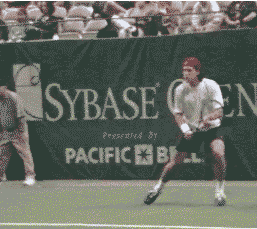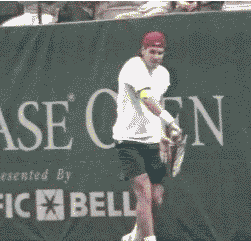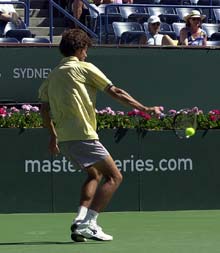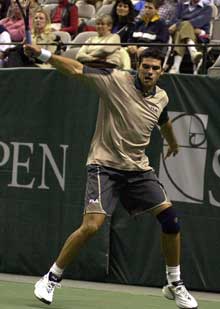<% ns_puts [mkm_getnavbar] %>

Myth of the Wrist:
The Backhand
by John Yandell
Still photos by J. Gregory Swendsen
Page 2 |
The One-Hander
|
Although it is less common on the one-handed
backhand, the belief still exists that the wrist plays a key role in
driving the ball with topspin. In general this can be traced, as on
the other strokes, to misperceptions regarding the sequence of motions by
top pros. My friend the tennis writer believes the wrist and
elbow must move upward independently to generate spin. But in
reality high speed video shows this element in the motion occurs
after the hit, if at all, and happens far too late to have an impact on
the actual shot.
Certain players tend to exaggerate elements in this relaxation and recovery phase more than others. In the case of two top one-handers such as Mark Philippoussis and Tommy Haas, there is often significant motion in the wrist and/or the elbow after the end of the technical swing.
|
Again, however, these distinctive recovery movements
occur many milliseconds after the hit. They are, unfortunately,
easier to see than the actual hitting arm at contact and at the critical
moments just before and after the hit. As our video shows both players
share a common hitting arm position before during and after the hit.
Like the forehand and the two-hander, this correct hitting arm position is critical on the one-handed backhand. For the one-hander, this position is with the hitting arm completely straight and the wrist locked. As the arm and racquet go through the hitting zone, there is no motion at either the elbow or the wrist.
|
Every top pro player establishes this straight
hitting arm position well before contact. In the case of Philippoussis, who has one of the most beautiful
one-handers in recent
history, this straight arm position is established at about the time the
racquet head starts to move forward to the ball. At this point, his
racquet hand is still very far back, roughly even with the middle of his
left rear leg.
Even a player such as Gustavo Kuerten who has the
highest backswing in the pro game with a severe bend in the elbow,
straightens out his arm well before the hit. In fact Kuerten, like
Philippoussis, gets to this position very early despite the size of his
windup.
Like the other groundstrokes the hitting arm position
on the one-hander remains unchanged through the hit and well out into the
followthrough. There is no significant internal arm motion. The straight arm position can continue until, like the two-hander, the
racquet hand and wrist reaches eye level or even higher.
|
Club players should try to model these basic hitting
arm positions in developing the core elements in either backhand. If the
core bio-mechanics are right, and the swing pattern is fast enough and
relaxed enough, the distinctive relaxation or wrapping movements will tend
to occur naturally and automatically.
High speed video has given us a look inside this previously invisible world of professional stroke production. No matter what commentators and magazine writers may say to perpetuate the myth of the wrist, any player who looks at the video here can see the truth for himself.
At the same time, this unique Advanced Tennis
video is a powerful tool for players to develop the right technical
elements for themselves. As Advanced Tennis research progresses, we
hope to reach more and more players and coaches. In the meantime,
this cutting edge knowledge is something that you may be able to turn to
your advantage against unsuspecting, less well-informed opponents.

For more information on John Yandell's Advanced Tennis Research Project, click here.
Last Updated 7/15/01. To contact us, please email to: webmaster@tennisone.com
TennisONE is a registered trademark of TennisONE and SportsWeb ONE; Copyright 1995. All rights reserved.




